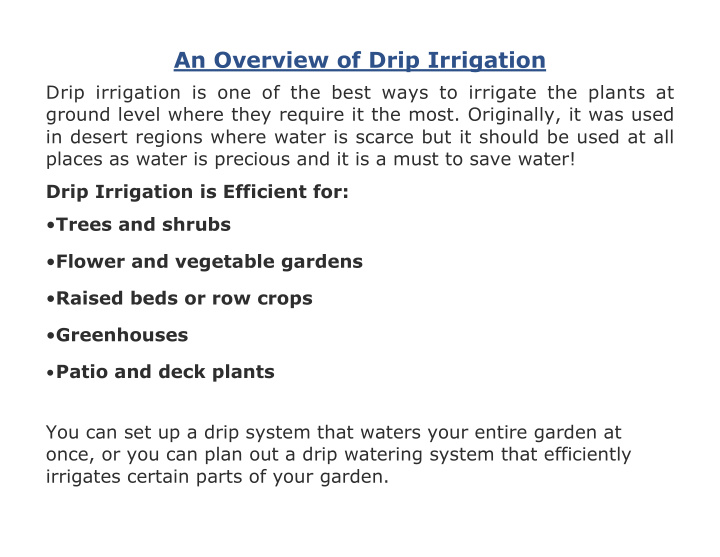



An Overview of Drip Irrigation Drip irrigation is one of the best ways to irrigate the plants at ground level where they require it the most. Originally, it was used in desert regions where water is scarce but it should be used at all places as water is precious and it is a must to save water! Drip Irrigation is Efficient for: • Trees and shrubs • Flower and vegetable gardens • Raised beds or row crops • Greenhouses Patio and deck plants • You can set up a drip system that waters your entire garden at once, or you can plan out a drip watering system that efficiently irrigates certain parts of your garden.
Advantages of Drip Irrigation A drip watering system, when designed and installed properly, and utilized making use of sufficient fertilizer and chemicals can provide huge benefits such as: • Highly efficient water supply • Suitable for almost all environments • Maintains moisture level in the soil • Reduces soil erosion • Effective for windy areas • Suitable for all sorts of plants and soil • No fear of water runoff and evaporation • Increases crops yields • Doesn’t waste water on weeds
Components of Drip Irrigation System With many different irrigation supplies and components available, many of which are interchangeable, you can set up a drip watering system that is easily expanded and modified. A basic drip system can be made using the following irrigation supplies: • Pipe and Tubing • Emitter • Backflow Prevention Device • Electric Control Valve • Filter • Pressure Regulator • Irrigation Timer/Clock End or Flush Cap •
Designing and Installing a Drip Irrigation System Design is an important aspect of a drip system because your irrigation schedule depends on it. While designing your system, keep in mind: • Different plants with different watering needs • Take your soil and slopes into your consideration • Water pressure • Exposure – what parts of the system will be exposed According to your plants’ irrigation needs, choose emitters and make sure where your joints and connectors should be best placed. Before digging up any trenches, you can lay the piping above ground so that you can see whether you have the best placement first.
A Drip System Installation The process of installing a drip irrigation system can be divided into the following simple steps: • Backflow Prevention Assembly • Valve Box • Dig Trenches • Pipes and Tubing • Irrigation Timer/Clock • Connect Clock to Valves • Emitters and Micro-tubing Backfill •
Drip Irrigation Tips Schedule and Automate Your Watering Task: 1. You can add a programmable timer/clock to your system so that your plants are watered a precise amount each day no matter you are home or away. 2. How frequently and many days you have to irrigate your plants depends on the soil type, the types of plants and emitters you use. 3. Flush your drip irrigation lines as well as filters every time when you change your irrigation schedule.
Check Moisture Level in Soil 4. If your plants seem to be stressed, check the moisture level in the soil. 5. If the soil is wet, then your plants may be over-watered. 6. If the soil is dry, then you should make sure whether all emitters are working properly. Know Your Flow 7. For determining how many emitters can be placed on each valve, you may require to know the rate of flow of your watering system.
Resources Rain Bird Drip / Trouble Shooting & Help http://www.rainbird.com/homeowner/products/drip/ Drip Irrigation Design Guidelines http://www.irrigationtutorials.com/dripguide.htm Rain Bird Online Irrigation Calculators http://www.rainbird.com/landscape/resources/calculators.htm City of Vallejo, Water Conservation http://www.vallejowater.org Lowe’s Home Improvement 401 Columbus Parkway, Vallejo http://www.lowes.com
Recommend
More recommend